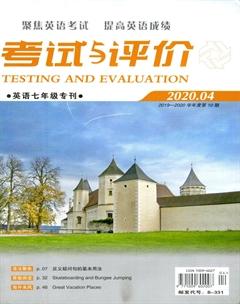反义疑问句的基本用法
张新峰
反意疑问句是由陈述句和附在其后的附加疑问句组成。其中附加疑问句是对陈述句所说的事实或观点提出疑问,起到证实作用,一般用于证实说话者所说的事实或观点。如:
Youre a student, arent you? 你是个学生,不是吗?
一、 反意疑问句的要点
1.反意疑问句前后两部分谓语应是:“肯定陈述+否定疑问”或“否定陈述+肯定疑问”。
2. 简略问句如果是否定式:not需与be,do,will等系动词、助动词、情态动词缩写。
3. 简略问句的主语不用名词,应用人称代词。
4. 陈述部分含“too...to”结构时,是否定句。
二、 反意疑问句的基本用法
1. 陈述部分是I am时,疑问部分要用 arent I. 如:
Im as tall as your sister, arent I? 我和你姐姐一样高,对吗?
2. 陈述部分有no, nothing, nobody, never, few, little等否定含义的词时,疑问部分用肯定问句。如:
The old man made no answer, did he? 那位老人没有作出回答,对吗?
Jim is never late for school, is he? 吉姆上学从不迟到,是吗?
3. 陈述部分有情态动词
在通常情况下,当陈述部分含有情态动词时,反意疑问句会重复前面同样的情态动词;若含有must,则反意疑问句可能用 mustnt或neednt (表示“必须”或“有必要”时),也可能根据must后的动词形式来确定(当must表示推测时)。如:
He can speak five languages, cant he? 他会说五种语言,是吗?
We must go with her, mustnt / neednt you? 我们必须(有必要)同她一起去,是吗?
The man must be rich, isnt he? 这人一定很富有,是吗?
4. 陈述部分有“Youd like to...”结构时,疑问部分用wouldnt +主语。如:
Youd like to go with me, wouldnt you? 你愿意和我一起走,不是吗?
5. 陈述部分主语是指示代词或不定代词everything, that, nothing, this时,疑问部分主语用it。如:
Everything is ready, isnt it? 一切都准备好了,不是嗎?
6. 陈述部分主语是不定代词everybody, anyone, somebody, nobody, no one等时,疑问部分常用复数,有时也用单数。如:
Everyone knows the answer, dont they? (doesnt he?) 每个人都知道答案,不是吗?
Nobody knows about it, do they? (does he?) 没有人知道,是吗?
7. 省去主语的祈使句的反意疑问句,疑问部分用will you。如:
Dont do that again, will you? 别再那样了,好吗?
Go with me, will you? 跟我去,好吗?
8. 以Lets 开头的祈使句,疑问部分常用shall we / shant we?而以Let us 开头的祈使句,后用will you / wont you? 如:
Lets go and listen to the music, shall we /shant we? 我们去听音乐,好吗?
Let us wait for you in the reading-room, will you / wont you?让我们在阅览室等你,好吗?

